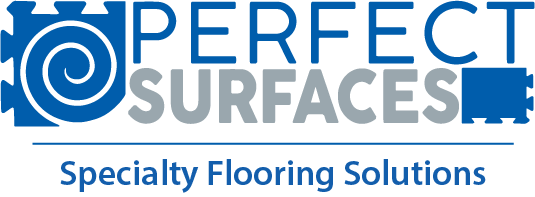Learn more about our playground safety surfaces…
Historically, outdoor playground surfaces were commonly only concrete or asphalt which have zero shock absorbing properties and can result in life-threatening injuries. Other play areas have grass or turf coverage, which offer only minimal shock absorbing properties, but are prone to accelerated degradation as a result of environmental conditions and recurring physical wear.
Many playgrounds have wood mulch, rubber mulch or pea gravel still, which offers inconsistent shock absorption as it can easily shift or move, causing level displacement- effectively nullifying any fall height rating it may have had at full depth not to mention the mess that it makes and maintenance and regular top ups required.
What is a fall-height rating?
Many facilities will require a play centre surface with a fall height rating as well – these ratings are assigned to a safety surface, indicating the height of which a fall can occur before resulting in injury.
The fall height rating requirement of the space can be satisfied by the density and thickness of the rubber flooring tiles or foam pads installed, to drastically increase the shock absorption properties of the play area.
For most home playground rubber surfaces, a 1.5’™ fall height is enough.
For commercial playground rubber surfacing, daycare playground areas and school playgrounds, a 4’™ or 6′ fall height is typically required; though typically, fall height requirements will range depending on the playground equipment.
What about other surfaces around the playground?
Many playgrounds also have areas, or ground level play areas that may require tiles or playground synthetic turf. Ensuring a perforated drainage tile for children’™s s will prevent excess moisture from accumulating on the surface, allowing for a drier and safer surface.
Playground artificial turf tolerates excessive wear and tear, is UV stable and resistant to extreme weather, making it extremely durable for playground applications. Playground turf padding is also available to satisfy fall height safety ratings.
5 benefits of rubber flooring
Rubber flooring is popular in gyms, healthcare facilities, ice rink arenas, schools, and other commercial settings for its incredibly resilient surface. This flooring type has become increasingly popular in residential applications for home gyms, kids’ playrooms, laundry rooms, and garages.
Rubber flooring is a truly versatile flooring option suitable for many applications. We list some of our favourite benefits of rubber flooring below.
- Durable and resilient – The natural elasticity of rubber makes for a durable and resilient flooring surface that can withstand a high volume of foot traffic. For this reason, most gyms use rubber in their facilities – especially for weight rooms that require a surface that can handle heavy equipment and the dropping of barbells, dumbbells, plates, and kettle balls. Rubber flooring is also excellent for absorbing impact and improves comfort, reducing the risk of injury and fatigue.
- Low maintenance – Water and a mild detergent – that’s all you need to keep this flooring clean and maintained! Avoid using harsh chemicals for cleans up because they can damage the rubber.
- Excellent slip resistance – Did you know that rubber flooring typically exceeds the standard of the “coefficient of friction” and is highly slip-resistant? This makes it an ideal flooring option for nursing homes, schools, play areas, and healthcare facilities where safety is the priority.
- Easy to install – Whether rubber tiles or mats, this flooring is easy to install over a flat and even subfloor. Interlocking rubber tiles are easy to place together, take apart, and store for a portable solution. Straight edge rubber tiles are ideal for covering small spaces, while rubber mats are excellent for large areas.
Tip: If you’re installing rubber flooring in the basement or over hardwood or engineered wood flooring, we recommend using a loose lay option such as our GatorLOC interlocking rubber tiles or VersaRUBBER rubber mats.
- Sustainable – Rubber is a natural raw material that is highly renewable. The material comes from the sap of a rubber tree extracted using a method that does not harm the tree’s growth. Rubber is highly renewable, recyclable, and is regularly reused for other applications. Recycled rubber is cut up into small pieces to be used for mulch and playground surfaces or to create new products.





